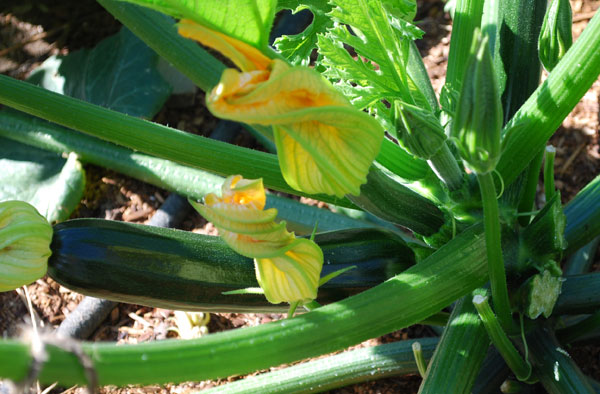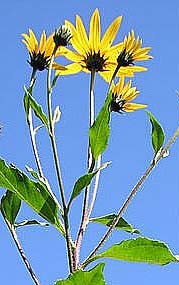| Symptom | Cause | Cure | Plants |
| Cluster of small, soft-bodied insects on buds and growth tips (gray, black, pink, green, red, or yellow in color); sticky secretions may be evident. Leaves are curled. | Aphids | Spray with neem oil or insecticidal soap. Use contact poison labeled for aphids on vegetables as recommended by a qualified professional. | Every garden vegetable |
| Irregularly shaped holes in the leaves; hard-shelled beetles of many colors and sizes | Beetles of various kinds | Pick off by hand or spray with a stomach poison insecticide as recommended by a qualified professional. | Every vegetable crop can be infested by one or more variety of beetles. |
| Growth tips wilted or entire plant wilted; small hole in plant stem at point where wilting begins | Borer | Cut out borer, or destroy entire plant if affected at base of plant. Spray base of plant with suitable stomach poison insecticide in late spring and early summer as recommended by a qualified professional. | Cucumber, Melon,Pumpkin, Squash |
| Irregular holes in foliage; Green caterpillars under and on top of leaves | Cabbage Worms | Inspect plants and pick by hand. Spray with Bacillus thuringiensis -- an organic insecticide -- or neem oil. Use a stomach poison insecticide as recommended by a qualified professional. | Broccolli,Cabbage,Cauliflower, others |
| Corn kernels eaten within the musk; insides of tomatoes, peppers, and eggplants eaten; yellow-tan worms found inside | Corn Earworm, Tomato Fruitworm | Remove infested plant debris at the end of the season. Apply insecticide recommended for earworms as recommended by a qualified professional. | Corn,Eggplant,Pepper,Tomato |
| Entire plant wilted or cut off at the base of the plant | Cutworms | Use paper collars, one inch above and one inch below ground level, around stems of transplants. | Cabbage,Pepper,Tomato |
| Slight wilting of the plant; plants growing poorly for no apparent reason; possible root damage | Grubs | Treat the soil with milky spore to control grubs. Control adult beetles with a stomach poison; apply soil drench of suitable insecticide, both as recommended by a qualified professional. | Most vegetables |
| Foliage turns yellow and begins to curl; small green-patterned, winged insects on undersides of leaves | Leaf Hoppers | Spray off light infestations with garden hose. Apply a stomach poison labeled for use on vegetables as recommended by a qualified professional. | Bean, Carrot, Chayote,Cucumber,Endive,Lettuce, Melon, Potato |
| Whitish trails visible on top sides of leaves; microscopic larvae of tiny flying insects | Leaf Miners | Remove infected leaves by hand. Keep garden weed-free. Remove and destroy infested plants in the fall. | Beet,Cabbage,Chard,Eggplant,Lettuce,Pepper, Squash,Tomato |
| Wilting of the plant; root inspection indicates yellowish,1/4- to 11/4-inch wormlike creatures. | Root Maggots | Discourage the fly from laying eggs near the seedlings by putting shields of plastic or paper 4 inches square around the seedlings. For heavy infestations, drench soil with insecticide labeled for control of root maggots as recommended by a qualified professional. | Cabbage,Carrot,Radish,Spinach, Squash,Turnip |
| A slime trail from plants that have irregular holes in leaves and lower stems | Snails and Slugs | Remove debris where they hide during the day. Shallow pans of beer will attract and drown pests. Commercial baits are available | Cabbage,Carrot,Lettuce,Tomato,Turnip |
| Yellowing leaves with speckled look; fine spider webs on backs of leaves and at point where leaves attach to stem; tiny reddish mites on webs and undersides of leaves | Spider Mites | Spray plants with miticide labeled for use on vegetables as recommended by a qualified professional. | Bean,Cucumber,Eggplant,Tomato |
| Distorted leaf tips, white irregular marks on leaves | Thrips | Hose off infected areas (insects are nearly invisible to the naked eye). Spray with a contact poison labeled for vegetable garden use as recommended by a qualified professional. | Bean,Cabbage,Carrot, Celery,Cucumber, Melon, Onion, Pea, Squash,Tomato,Turnip |
| Leaves and fruit of tomatoes and related plants eaten; four-inch green and white caterpillarlike worm found on plants. | Tomato Hornworm | Remove worms by hand as they are discovered. Spray with Bacillus thuringiensis, neem oil, or stomach poison insecticide as recommended by a qualified professional. | Eggplant,Pepper,Tomato |
| Tiny white insects fly from plant when disturbed. Large infestations weaken plant by feeding on undersides of foliage. | White Flies | Light infestations can be sprayed off with garden hose or neem oil. Spray contact poison labeled for white fly on vegetables as recommended by a qualified professional. | Eggplant,Pepper,Sweet Potato,Tomato |
| Poorly grown, yellow, wilted plants; hard, one-inch, golden worms feed on seeds, roots, and lower stems. | Wireworms | Drench soil with recommended insecticide as recommended by a qualified professional. Control adults (click beetles) later in the season. | Carrot,Lettuce,Potato,Tomato, others |















